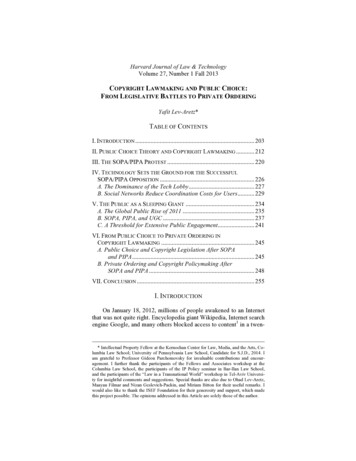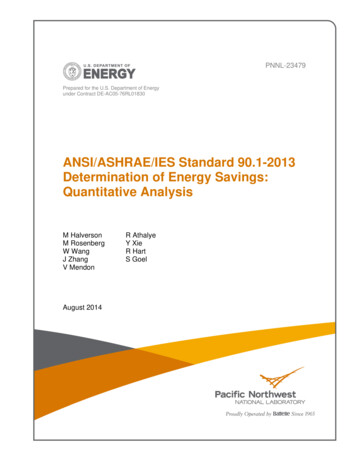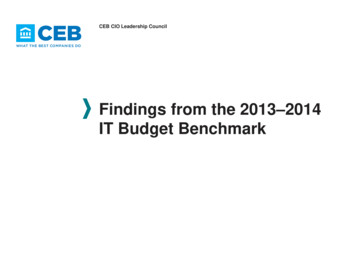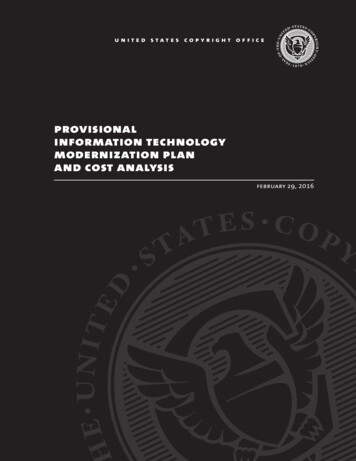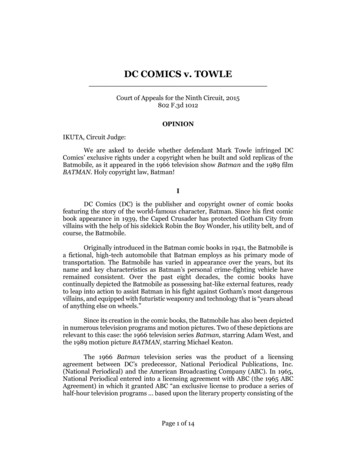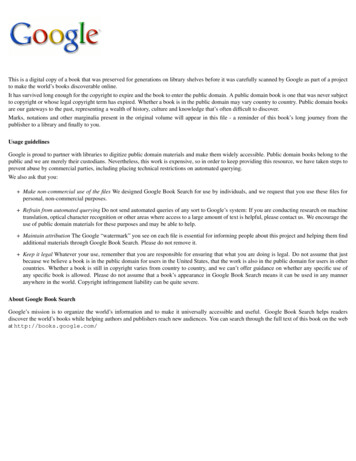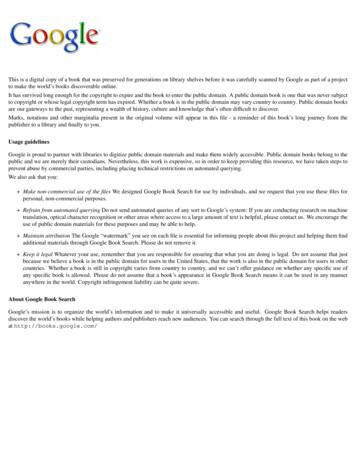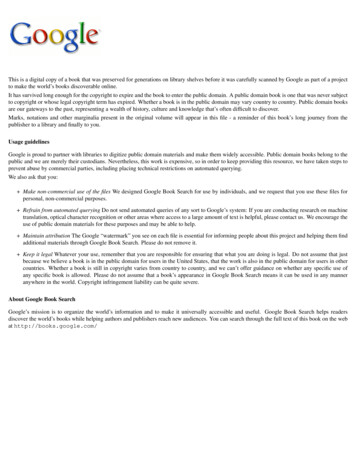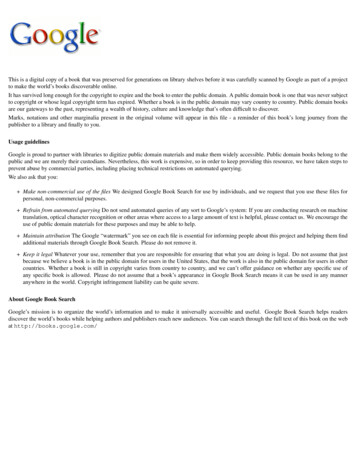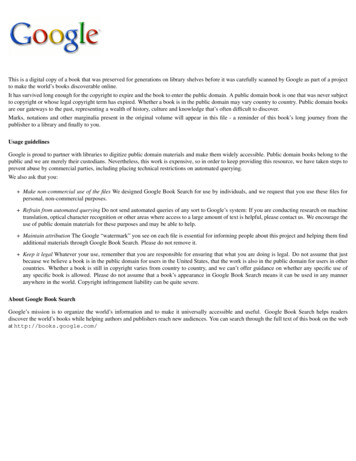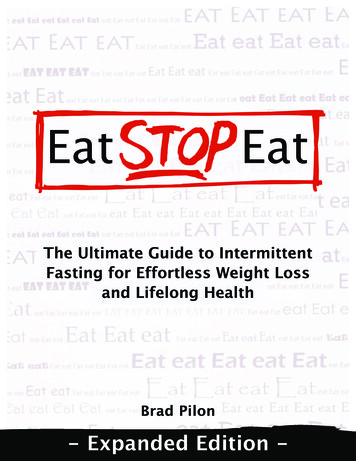
Transcription
Copyright 2013 and Beyond by StrengthWorks International Publishing Inc.All rights ReservedNo portion of this book may be used, reproduced, or transmitted in any form or byany means, electronic or mechanical, including fax, photocopy, recording, or anyinformation storage and retrieval system by anyone but the purchaser for their ownpersonal use. This manual may not be reproduced in any form without the expresswritten permission of Brad Pilon, except in the case of a reviewer who wishes to quotebrief passages for the sake of a review written for inclusion in a magazine, newspaper,or journal, and all of these situations require the written approval of Brad Pilon priorto publication.The information in this book is for educational purposes only. The information inthis book is based on my own personal experiences and my own interpretation ofavailable research. It is not medical advice and I am not a medical doctor.The information within this book is meant for healthy adult individuals. Youshould consult with your physician to make sure it is appropriate for your individualcircumstances. Keep in mind that nutritional needs vary from person to person,depending on age, sex, health status and total diet.If you have any health issues or concerns please consult with your physician.Always consult your physician before beginning or making any changes in your diet orexercise program, for diagnosis and treatment of illness and injuries, and for adviceregarding medications.Eat Stop Eat1
This book is dedicated to the loving memory of Dr. H. Frank FarmerEat Stop Eat2
ContentsA Special Note5Preface10How it All Started13Introduction16The Fasted State21The Disappearance of the Fasted State24Forget Everything You Have Ever Read About Fasting28Fasting and Your Metabolism32Fasting and Exercise38Fasting and your Brain44Fasting and Your Muscle Mass46Fasting and Hunger53Fasting and Blood Sugar Levels59Other Misconceptions of Fasting63Fasting and Leptin63Fasting and Testosterone68Fasting and Cortisol72Fasting and Breakfast75The Health Benefits of Fasting79Decreased Insulin Levels & Increased Insulin Sensitivity83Decreased Blood Glucose Levels88Eat Stop Eat3
Increased Lipolysis and Fat Burning88Increased Glucagon Levels92Increased Epinephrine and Norepinephrine levels93Increased Growth Hormone Levels93Increased Weight Loss and Increased Fat Loss101Decreased Chronic Inflammation103Increased Cellular Cleaning107Health Benefits – The Conclusion111The Eat Stop Eat Way of Life113How to fast Eat Stop Eat style116Eat Stop Eat – Why not Longer Fasts121How to Eat Eat Stop Eat style126What to do While Fasting137Fasting and Women140How to work out with Eat Stop Eat148Designing your own workout program154Sticking with it155A note on cardio for weight loss156Other Health Benefits of Exercise162How to keep it off163Eat Stop Eat as Training166Eat Stop Eat Conclusions173Eat Stop Eat Frequently Asked Questions177References190Eat Stop Eat4
A Special Note on This EditionFirst of all, let me be clear that I was well aware of the immense gap betweenpeoples’ attitude toward health and fitness and the theories found within this bookback when it when was first published in 2007.I knew that people had generally accepted that strict dietary restraint and an almostrelentless workout program were essential for weight loss. Not only this, but it wasbelieved that a serious lifestyle modification had to occur that made you almostobsessed with health and nutrition.I was all too aware that for some curious reason we had accepted the idea that losingweight had to be extremely difficult and the concept that long-term weight losssuccess meant a life of dedication and extreme discipline.Back in 2007, even the slightest suggestion that we could actually cause a genuinereduction of body fat WITHOUT extremely regimented and inflexible dietaryrestrictions was often met not only with disbelief, but also hostility. Few wereprepared to hear or accept a simpler solution.Eat Stop Eat5
The diet industry is huge, and worth billions of dollars in annual profits. This not onlyincludes the obvious examples of over the counter diet pills, but also weight losscenters, weight loss coaches, weight loss books, and even on-line weight loss societies.Combine this with the shocking boom of twenty-something year old Internetmarketers making millions selling ‘diet advice’ on-line and it becomes obvious that theweight loss industry was ready for a big, strong dose of common-sense thinking.I knew that Eat Stop Eat was going to cause a shockwave in the diet industry, and thatI was going to have to spend a great deal of my time defending the concepts within it.But like I said, this was almost a given. It is the NORM for radical new concepts thatreceive a lot of attention to arouse a sharp division of opinion among expert‘commentators’.Yet the fight for Eat Stop Eat’s acceptance was not nearly as uphill as I had imagined.Sure, it had its detractors and nay-sayers, but for the most part even the harshestscientific critic quickly came to realize the simplicity and effectiveness of Eat Stop Eatand appreciated that it was supported by very sound and logical scientific evidence.It seems that in a matter of just 3 short years, Eat Stop Eat has gone from being acontroversial ‘fringe’ dietary ‘fad’ to becoming an accepted dietary approach to losingweight that is being supported by doctors, dietitians, and other mainstream healthexperts.Eat Stop Eat6
Biologist J.B.S. Haldane said it best when he pointed out that there are four stages ofscientific acceptance:1) This is worthless nonsense2) This is an interesting but perverse point of view3) This is true but quite unimportant4) I always said soEat Stop Eat has hit the “I always said so” phase of acceptance. This is very exciting tome, and many others involved in the diet and weight loss industry.People have begun to accept that losing weight can be accomplished using a multitudeof different diets, as long as the diet created some sort of decrease in caloric intake.Not only this, but the concept that the best diet is the one you enjoy and can stay onthe longest, has really caught on.Despite these facts, there is still a growing amount of nutrition misinformation that isavailable in the mainstream weight loss industry. And, quite ironically, obesity ratesare still increasing. In fact, the average percent body fat in North America has becomestartlingly high.Eat Stop Eat7
(The average body fat for men is 25% and for women is closer to 40%)Common sense and sensibility merges with the weight loss industry.The simple truth is that research illustrates an increased supply of food is more thansufficient to explain this obesity epidemic.1 I am almost positive that no one is happywith the North American average of 25% and 40% body fat for men and women,respectively.2 As such, there is still a need to expand on the successful theories of EatStop Eat to help as many people as possible realize that weight loss does not have tobe complicated.Let’s start with what we already know about weight loss: Carrying extra body fat is really bad for us, both physically and emotionally.Eat Stop Eat8
Weight loss is not a mystery and the fundamental principles have neverchanged. It’s our ability to apply these principles that dictates how successfulwe are at losing weight. Since you are reading this book, you have a personal interest in weight loss.A Caveat: Prevention is better than a cure.While the principles of Eat Stop Eat are often only thought of as a way to lose weight, itis important to remember that Eat Stop Eat is also an effective way to maintain weightloss, AND to prevent weight gain from happening in the first place.Simply put, when adapted to fit your own personal lifestyle, the principles of Eat StopEat can apply to everyone.Eat Stop Eat9
PrefaceTake a second before reading this book and think about all the diets you haveheard about and read about in recent years. Each diet had its own little hook thatmade it stand out, and each diet had thousands of loyal followers that swore thattheir diet was the only one that worked.Now consider the real-world evidence that is right before your eyes. Every day you seehundreds of people, all with different body shapes and all following different diets.I will use professional bodybuilding as an example. Imagine two groups ofbodybuilders ready to step on stage at the highest level of competition; their veinspopping out everywhere, with tanned, oiled skin, and almost nonexistent body fat.The first group consists of bodybuilders from the 1950’s and 1960’s. Thesebodybuilders were able to get into phenomenal shape using diets that were low in fat,high in carbohydrates with moderate amounts of protein. The second group consistsof bodybuilders from the 1990’s and beyond. They got into phenomenal shape usingvery different diets that consist of moderate amounts of fat, low carbohydrates, andvery high amounts of protein.Eat Stop Eat10
Both groups of bodybuilders were unbelievably lean. Both groups used varioussupplements and drugs. However, both groups followed very different nutrition plans.Yet, somehow they all managed to get their body fat down to unbelievably low buildershavechangeddramatically. Depending on the bodybuilder and the era, they may have eaten sixmeals a day, or they may have eaten more than a dozen. Some bodybuilders ate redmeat while others did not. Some did hours of cardio, some did no cardio at all, yetthey were all able to lose fat and get into ‘contest shape’.The reason all these bodybuilders could get in shape on so many different styles ofdiets is simple: for short periods of time, every diet will work if it recommends someform of caloric restriction. And if you follow a calorie-restricted diet you will loseweight, guaranteed.The problem is, you simply cannot follow a super-restrictive diet for a long period oftime. Sure, a truly dedicated individual may be able to follow a very restrictive diet for12 weeks and get into phenomenal shape. With the right amount of dedication, aperson can even look like they just stepped off the cover of a fitness magazine. And avery small and unique group can do this for years on end.For the rest of us, this way of eating is too restrictive, too intrusive on our lives, andfar too limiting to be done effectively for any real length of time.Now, what if I told you that these types of long restrictive diets are simply notnecessary for weight loss? What if I told you that there is a way to eat and a way tolive that can give you amazing health benefits, help you lose weight, and does notinvolve any prolonged periods of food restrictions, eating schedules, supplements, ormeal plans?Eat Stop Eat11
In the following pages I am going to share with you a discovery that I made as a resultof years of research and schooling, a career in the sports supplement industry, and anobsession with nutrition.I am going to present you with the reasons why I think most diet plans areunnecessary, too restrictive, and ultimately too complicated to work long term. Andmost importantly, I am going to describe what I believe to be the single best way to eatand live that will help you lose weight and keep it off, without any of the complexplans, rules, and equations that is typical of most diets.After all, I don’t consider this method of eating a diet. It’s a way of eating that restrictscalories, but that can also ultimately grow into a way of life.I must warn you in advance, many of these ideas are ‘different’ in that they do notagree with the current nutrition trends. I promised myself when starting this projectthat I would not merely accept the current rules of nutrition just because theyhappened to be the rules that are currently en vogue.As the bodybuilders in the example prove, many different styles of nutrition can resultin the development of astonishing physiques. There probably is no “right” way to eat.The best we can hope for is finding the way that works the best for you.Nutrition, just like all science and medicine, is always evolving and changing. So eventhough the ideas in this book may be unconventional by today’s standards, I believethat someday they just might be the new rules of nutrition!I am positive that if you read this book with an open mind, you will find thateverything I have written makes sense. It may be different than what everyone else istelling you, but it is proven and backed up by a large quantity of scientific research,and it can change your life.Eat Stop Eat12
How it All StartedI walked away from my career in the sports supplement industry in May of2006. It wasn’t a bad split, and I did not want to give up on the industry altogether, Ijust wanted to start fresh.To fully explain this decision, I have to take you back about twenty years.I have always been obsessed with exercise, health, and nutrition. At 10 years old, Icould already boast a very impressive collection of Muscle & Fitness Magazine, and acouple of years later I was also collecting issues of Men’s Health. I can rememberreading about bodybuilders like Lee Haney, Arnold Schwarzenegger and Lou Ferrignoand all of the articles concerning their diet and exercise programs. It was thesearticles that piqued my interest in the science behind fat loss.At 16 years old, I had a subscription to the American Journal of Clinical Nutrition. Iwould read any research paper that involved nutrition and fat loss. It would take meabout a day to read each article because I had to stop and check almost every word ina medical dictionary.At 17 years of age, I started working at a local supplement store. This was my firstofficial step into the health and nutrition industry and I have never looked back.Eat Stop Eat13
When I started studying nutrition at university, I had only two goals – to learneverything I possibly could about nutrition and metabolism, and to graduate withhonors. In the spring of 2000, I accomplished both of them. Almost immediately aftergraduating from university, I was fortunate enough to be hired as a research analystat one of the world’s leading supplement companies.Fast-forward to June of 2006. I had just spent the last six years of my life working inone of the most secretive industries in the world. During this time, I had beenentrusted with protecting some of the most confidential information in the entireindustry.I was the person responsible for the inner dealings of our Research &Development Department. Unfortunately, this was part of the problem.Part of my job was to review bodybuilding and fitness magazines. Every month I wouldhave to read through the top ten magazines on the market. I was constantly readingabout the ‘latest and greatest’ diet methods. After years of reading magazine aftermagazine, I didn’t know what to believe anymore.Each month, it seemed like thenewest diet methods contradicted the diet methods that were in last month’smagazines. I started to think that the weight loss industry was full of nothing butconfusing and constantly recycled misinformation.When it came to the science of losing weight, every so-called ‘nutrition guru’ andweight-loss personality had his or her own theories on what did and didn’t work. Afteryears of reading and evaluating all of these nutrition and diet programs, I was actuallystarting to ignore my previous doubts and get consumed by the hype!Despite all of my formal education in the nutrition field, even the most absurd diettheories eventually started to sound logical to me, even though I had never comeacross any research that could convince me that these theories were supported bystrong scientific evidence.Eat Stop Eat14
In reality, the vast majority of what I had read in these magazines was just theoriesand speculation. Some of them were based on science while others were completegibberish.Many were contradictory to one another, and others even defied thefundamental laws of thermodynamics and science.Month after month, dozens of magazines would appear on my desk, and month aftermonth, I would see new and old diet ideas being trumpeted as the newest, mosteffective way to ‘blowtorch through stubborn body fat’.At this point, I noticed a funny thing about the industry - if an idea is publishedenough times, and if enough people accept it, it becomes true, no matter howinaccurate it really was.Whoever said, “you can say the same lie a thousand times but it doesn’t get any moretrue,” has obviously never been involved in the nutrition industry!The bottom line is that I got into the sports supplement industry for the same reason Ieventually left. I wanted to understand the true rules of weight loss, and I wanted tofigure out how we should really eat for health, energy, peak performance, and forweight loss.I ended up leaving my career in the industry so that I could write this book.Eat Stop Eat15
IntroductionAs part of the background research for this book, I made it my goal to uncoverthe true scientific facts behind weight loss and nutrition.I’m not talking about the scientific ‘facts’ that are thrown around every day by foodcompanies and marketing gurus. You know, the ‘eat this, not that’ facts or the ‘recentresearch has shown’ ‘facts’. I wanted to find the cold, hard truths. I was looking for thenutritional equivalent of death and taxes.My first step in this quest was to read every nutrition and diet book I could get myhands on. I read and re-read the following books:The Atkins revolution, Protein power, Body for Life, The Zone, The South BeachDiet, French Women Don’t Get Fat, The Warrior Diet, The Metabolic Diet,Volumetrics, The Obesity Myth, Health Food Junkies, An Apple a Day, What toEat, the Omnivore’s Dilemma, Real Foods, The End of Overeating, Eat Right 4Your Type, Good Calories Bad Calories, Food Politics, as well as various‘underground’ books on diet and nutrition like Dan Duchaine’s Body Opus.I didn’t just read these books. I analyzed them. I compared marketing tactics, writingstyles, and persuasion techniques. If the book quoted scientific references, I soughtEat Stop Eat16
out the reference and reviewed it in its entirety. My goal was to dissect our currentnutrition beliefs and to find track their evolutions and origins.On top of this, I also read and critically analyzed hundreds (not an exaggeration) ofresearch papers, and re-read several of my nutrition textbooks.I even went so far as to enroll in graduate school to study Human Biology andNutritional Sciences, and let me tell you, it took an almost unhealthy desire touncover the truth to drive me to re-enroll in school after a seven-year hiatus, with apregnant wife and a busy consulting job! It was a long commute back and forth fromschool every day, but having the opportunity to study nutrition at the graduate levelwas worth the sacrifice.So what did all of my research uncover? Firstly, I can say that most (but not all)people who talk about scientific research on-line or in magazines are not crediblesources of scientific information, nor can they properly analyze the meaning of anyscientific research.What they do is called “data mining”, where they scan research papers looking forinteresting sound bites or quotes. Basically, they try to summarize 2 to 3 years worthof scientific investigation in one short and snappy quote. It’s great reading, but itrarely gets to the truth of the topic. This is not meant as a self-serving ego-boostingstatement, but rather as a testament to the importance of obtaining a propereducation.I also realized that even having an advanced education in one specific topic does notmake you an expert in all things health related. Having a PhD in muscle physiologydoes not make you an expert in fat loss, and vice versa. Nor does being a MedicalDoctor necessarily give you the scientific background you need in order to trulyunderstand the complexities of nutrition, and more importantly to be able to seeEat Stop Eat17
through the deceptiveness of nutrition marketing (many U.S. medical schools fail tomeet the minimum 25 required hours of nutrition education set by the NationalAcademy of Sciences).3Finally, I can tell you that based on my research studying nutrition, fasting, andweight loss in graduate school, I have realized that there are only two absolute truthswhen it comes to nutrition and weight loss.1) nalmethodofweightlossand2) rfasted.That’s it. In my opinion, these are the only two facts that are undeniable. Everythingelse is open for debate, which is the problem with nutrition today – it is made out tobe so complicated and confusing that nobody knows what to believe.Most scientific research findings seem to do nothing more than add to the alreadyconfused and muddled nutritional theories and diet recommendations that exist, andthe cause is clear as day – research on nutrition and food is no longer conducted toimprove our health and well being. It is conducted for marketing purposes and as amethod to get us to buy one product over another, and it is all based on us beingconstant consumers.Eat Stop Eat18
In fact, it was in an amazing article in Scientific American magazine written byrenowned food expert Dr. Marion Nestle where I became aware that it was in the early1980’s food companies had no choice but to attempt to change the way we eat. Facedby stockholder demands for higher short-term returns on investments, foodcompanies were forced to expand sales in a marketplace that already contained anexcessive amount of calories.Their only option was to seek new sales and marketing opportunities by encouragingformerly shunned eating practices such as frequent between-meal snacking, eating inbookstores, and promoting the money-saving value of larger serving sizes.4To be clear, our entire style of eating in North America has been molded to supportthe interests of major food companies.You may be wondering ‘How can a select few people change the way entire countriesdecide to eat?’ Well, in order to promote this new style of eating, enormous amounts ofmoney had to be spent on research supporting the health benefits of this style ofeating.As far as I can tell, most research being conducted on food and nutrition these days isdone simply for the purpose of food marketing. This is because the money that fundsnutrition research is typically donated by a food company or supplement company.This so-called ‘donation’ or grant comes with the hope and expectation that theresearch will produce a health claim or other marketing claim that the company canthen advertise as a selling feature for their product. As it turns out, health claims onfoods and supplements can be incredibly lucrative, and the politics behind nutritionare undeniable.Eat Stop Eat19
It was in a book titled “What to Eat” by author and researcher Marion Nestle (the sameauthor who wrote the article in Scientific American), where I read the following quote –“The real reason for health claims is well established: health claims sell food products.”5I couldn’t agree more.The bottom line is that research creates health claims, and health claims sellproducts. Whether the product is some new ‘functional’ food or the latest dietprogram, if research says it works, it will sell more, guaranteed.Very soon into my readings I began to realize that the research on weight loss hadbecome so skewed with politics that it has turned into the world’s most ironicoxymoron. After all, the research was trying to uncover the completely backwardsidea; ‘what should we eat to lose weight?!’When I realized that almost all nutrition research was working under this completelybackwards paradigm, I understood that I had only one choice. If I was to avoid all ofthe bias and vested influence in today’s nutrition research then I had to go back to theabsolute beginning. I had to conduct a thorough review of exactly what happens tohuman beings in the complete absence of food.Eat Stop Eat20
The Fasted StateThe definition of fasting is quite simple. I’ve read through countless dictionaryentries and website descriptions of fasting, and have decided that the best definitionof fasting is the following: “The act of willingly abstaining from some or all food,and in some cases drink, for a pre-determined period of time.” The key word inthis definition is “willingly” as it is the difference between fasting and starving. Otherthan this one small difference, the net result is the same – the purposeful abstinencefrom caloric intake over a given period of time.Now, a lot of people confuse 'starvation' with wasting - wasting is the end result ofprolonged caloric restriction - where your fat reserves are almost completely used upand can no longer supply your body with enough energy to meet its needs. This iswhen you see abnormal physiology such as muscle wasting (loss) and a slowedmetabolism and altered hormone profiles. So 'wasting' is the end result of prolongedextreme calorie restriction – occurring after months or even years of a chronically lowintake and possible nutrient deficiencies, but not something that happens in a 72hour period without food.So you are either fed or fasted, however ‘fasted’ can mean 12 hours or 12 weeks, so forthe purpose of my research I decided to focus on short-term fasting, studying themetabolic effects of fasting between 12 and 72 hours. The minute you start fasting(stop eating) your body slowly begins to enter the fasted state. As you slowly use upEat Stop Eat21
the energy and nutrients supplied by your last meal, you also slowly begin to ramp upthe amount of energy you supply from you body fat. For most people you fully enterthe fasted state, using mostly body fat as a fuel, by about 24 hours since you finishedyour last meal.So ‘fasting’ begins the moment you stop eating, after which you slowly enter the‘fasted state’.The amount of time it takes to fully enter the fasted state dependslargely on the size of your last meal, but in general occurs somewhere between 16 and24 hours of fasting.Throughout history, various cultures have used fasting in many different types ofrituals and celebrations, and still use fasting within those traditions to this day.Almost all major religions have a degree of fasting built into them. From politicalprotests to healing rituals, and even for good-old weight loss, there are manyhistorical accounts of various people fasting for different reasons. With the exceptionof fasting for religious purposes, the practice of fasting has all but disappeared inNorth America.Our ancestors also fasted simply due to the poor availability of food, or as a way tocleanse and heal their bodies. While modern-day humans in many developedcountries are used to being able to eat a solid three meals per day, animals in the wildeat only when food is available, and most likely this is also how our hunter-gathererancestors ate.And let’s not forget that the majority of the world’s population still lives withoutadequate food supply. The fact that we’re faced with a problem of too much foodmakes us the lucky ones. Of course, this creates an odd sort of irony in the fact thatyou are now reading a book about how to deal with the consequences of the extrafood.Eat Stop Eat22
While researching, I observed that studying short-term fasting was an excellent way touncover the truth behind nutrition and fat loss. This was because people with vestedinterests in selling consumable products have no interest in studying fasting.Fasting automatically rules out the use of any sort of food, health supplement, ornewly touted “functional foods”. Much to the dismay of food companies, you can’t putfasting into a pill and sell it, and as we have already discussed, the purpose of mostnutrition research these days is the development of new products.By default, because you do not consume anything while you are fasting, research onfasting contains very little bias from large food company funding. After all, why woulda food company spend money proving there is a benefit to eating less of theirproducts?Another benefit of studying fasting is that there is an extremely large volume ofresearch that has been conducted on fasting, and more research comes out almostevery day. So anyone who suggests there is no scientific data on fasting couldn’t befurther from the truth.Eat Stop Eat23
The Disappearance of the Fasted StateAs I stated in the beginning of this book, from a nutritional point of view, ahuman being can only be fed or fasted. By saying this, I mean that we are either inthe process of eating and storing the calories that come from our food, or burningthese same calories as we burn stored energy. This energy is stored in the form of fatand glycogen (the storage form of sugars and carbohydrates in our bodies).Our bodies are designed to eat food when food is available and use the calories wehave stored as fat when food is scarce. These are our only two options. Consider themthe Yin and Yang of nutrition and health.FED - Eating and storing CaloriesFASTED - Not eating and burning Calories.Eat Stop Eat24
Fasting is the simplest method our body has for maintaining its caloric balance. Storea little when we eat, burn a little when we don’t eat. Recent research suggests theproblem is that we spend as much as 20 hours a day in the fed state.6 We areconstantly eating and storing food and we never really give ourselves a chance to burnit off.So the yin and yang of fed and fasted has been replaced by a constant fed state, wherewe helplessly try to figure out how to continue eating and somehow lose weight at thesame time. This is a very scary scenario when you consider the fact that our bodiesare designed to store fat whenever it is provided with an amount of calories beyond itsneeds. In order to restore the balance of fed and fasted states, we have no choice but
Eat Stop Eat 4 Increased Lipolysis and Fat Burning 88 Increased Glucagon Levels 92 Increased Epinephrine and Norepinephrine levels 93 Increased Growth Hormone Levels 93 Increased Weight Loss and Increased Fat Lo ss 101 Decreased Chronic Inflammation 103 Increased Cellular Cleaning 107 Health Benefits - The Conclusion 111 The Eat Stop Eat Way of Life 113

